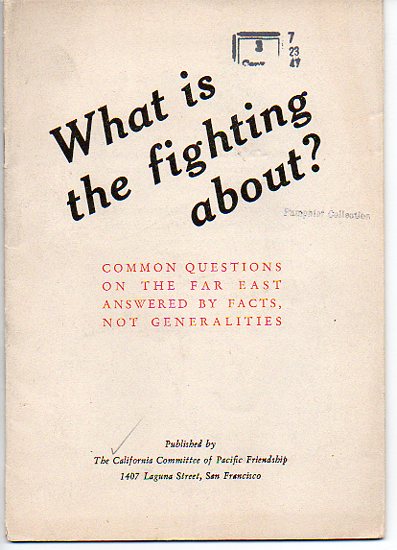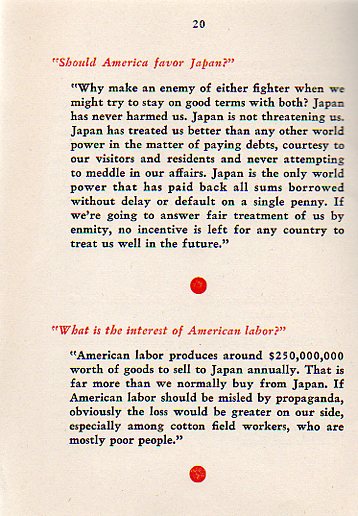ITEM: What is the fighting about? Common Questions on the Far East Answered by Facts, not Generalities. The California Committee of Pacific Friendship, San Francisco, 1937. 20pp. Very good condition. $75.00
Ref: JF Ptak Science Books Post 1319
This little pamphlet is a great example of The Big Lie--propaganda so vast and so vicious and so far from the truth that people tend to believe it because, well, because no one would or could tell lies so Gargantuan and Pantagruelian and expect to get away with it. They were statements so spectacular and seemingly untrue that their very reverse weight gave them weight enough to necessitate "truth". Mostly on this blog the Big Lies I've dealt with came out of Germany--these had to do with the International Jewish Conspiracy, the plot of Poland to attack Germany, the resettlement that was going to be provided for French workers who came to the Nazi's side to do technical work for the Wehrmacht, and so on.
 In this case it is Japan's turn at The Big Lie to make its case to justify its already long and very bloody attack and occupation of China. In short, what the publishers--the California Committee of Pacific Friendship (located at 1407 Laguna Street in San Francisco, the site of which today is ironically occupied by the Chinese Consulate)--tell their American audience is: that the Japanese are not aggressive; that China was planning to attack Japan to help unify their own country; that Japan needed to occupy Manchuria to protect Japanese citizens; that at the same time Japan was invited into China and was not going to leave because no one else does; and that is it is in the best interest of the U.S. to continue its valuable trade with Japan in order to protect the poor people who pick cotton that goes into essential American-Japanese trade. Virtually everything in this report is nothing. Thats what makes it a Big Lie. [This pamphlet is available at our blog bookstore.]
In this case it is Japan's turn at The Big Lie to make its case to justify its already long and very bloody attack and occupation of China. In short, what the publishers--the California Committee of Pacific Friendship (located at 1407 Laguna Street in San Francisco, the site of which today is ironically occupied by the Chinese Consulate)--tell their American audience is: that the Japanese are not aggressive; that China was planning to attack Japan to help unify their own country; that Japan needed to occupy Manchuria to protect Japanese citizens; that at the same time Japan was invited into China and was not going to leave because no one else does; and that is it is in the best interest of the U.S. to continue its valuable trade with Japan in order to protect the poor people who pick cotton that goes into essential American-Japanese trade. Virtually everything in this report is nothing. Thats what makes it a Big Lie. [This pamphlet is available at our blog bookstore.]
Part of the issue of invading China' was to prevent Chinese aggression towards Japanese citizens, which was “a politically attractive campaign” and a cause of :China’s backwardness”.
There is no mention of Japan’s invasion of Manchuria in September 1931 following the Mukden Incident, an earlier version of a Gulf of Tonkin incident, a manufactured bit of terrorism by the Japanese military perpetuated against itself to give the Empire a reason to attack China. . Manchuria was subdued by 1932 and renamed Manchuko, and then used by the Japanese for its fantastic assembly of raw materials.
In the same vein it was alleged in this pamphlet that it was China which bombed itself at Shanghai (Songhu), not the Japanese, starting what would be months of fighting in one of the largest and bloodiest battles of the 1937-1945 war. It doesn’t make much sense for this top be the case, as the National Revolutionary Army of the Republic of China was vastly over matched by the Imperial Japanese Army of the Empire of Japan. (The Chinese enjoyed a 2:1 advantage in troop strength, but totally overwhelmed by Japanese tank and aircraft numbers and tech superiority.) This pamphlet was published in November 1937, so the end of this battle–the first really of that would be twenty-two or so major engagements of the war--was still months away. No doubt that an updated version of this pamphlet printed in 1938 would note the 70,000 Japanese soldiers killed without mentioning their own belligerent status or the 200k Chinese killed during the same time.

The Japanese wouldn’t have to bother with this sort of propaganda after 7 December 1941. It would’ve been hard to explain it all, especially the 17,000,000 Chinese civilians being killed in the process. And the 3 million Chinese soldiers1. Quite a long and twisting road from protecting Japanese citizens in Manchuria in 1931.
Notes
1. Nationalist Chinese military forces included 1,320,000 killed in action, plus 1,797,000 wounded, with another 120,000 MIA. The Communist Chinese forces included another : 500,000 total casualties. Japanese forces include about 396,000 KIA plus another 430,000 MIA and WIA. Another estimate from the Japanese side gives the figures for Japan’s losses at ( 1937–1941) 185,647 KIA. 496,000 wounded, and 430,000 incapacitated; plus for the 1941–1945 period, another 202,958 dead. Nationalist Chinese estimates for Japan’s losses for 1937-1945 were 1.77 million KIA and 1.9 million WIA



Comments